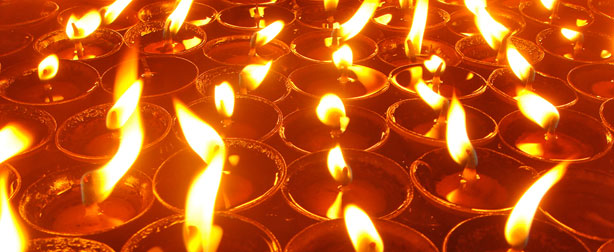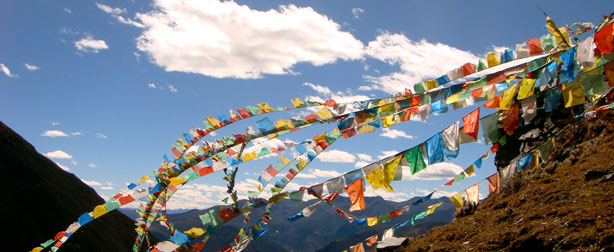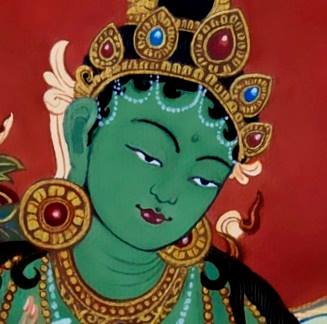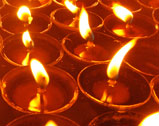Meditation
“The contrast between Buddha’s and sentient beings is like that between narrowness and open space. A sentient beings mind is like the space held within a tightly close fist, whle a Buddha’s is fully open, all-encompassing.” Tulku Urgyen Rinpoche
Many people are becoming aware of the benefits of meditation training, mindfulness and compassion, but what is meditation and how do we practice it? Chökyi Nyima Rinpoche explains in his book Indisputable Truth
“When loving friends want to console or to relieve another’s pain, they say, “Relax, don’t worry.” This is really one of the finest statements that a person can make. Relaxation – especially mental relaxation – is something basic and extremely beneficial. It is human nature to strive for material gain, sense pleasures, a good reputation and appreciation from others, often in an intense or even desperate way. Unless we can relax and not be so caught up, our relationship to enjoyments and wealth becomes hollow and substanceless, almost as if we were robots.
When someone whose heart is troubled and worried is, out of true affection and kindness, told “Relax, don’t worry,” this statement helps and can make a big difference. Telling someone to let go and relax can instill a sense of peace. This holds true not only for human beings but also for animals. When you show a genuinely loving expression on your face and kindly stroke an animal with your hand, these actions help it to feel at ease. Most important is to behave with love and compassion, expressing these feelings by being gentle and affectionate. The opposite of this is to act out of anger and to be aggressive towards others.
This is why the perfectly enlightened one, the Buddha, said “Rest calmly.” In fact, teachings on the practice of shamatha sound very much like “Relax, don’t worry.” When we tell each other “Relax!” the power of just that one word has some kind of deep impact. Most people using the word don’t really know the true depth of the meaning of “relax.” We say “Relax!,” but that which prevents us from being relaxed is, on a coarse level, our own disturbing emotions. On a more subtle level, that which prevents an utterly relaxed state of mind is subconscious thought activity, an almost unnoticedundercurrent of conceptual thinking.
When the Buddha said “Practice shamatha, rest calmly,” he was giving affectionate advice. He was telling us to try to be at peace with ourselves, to remain like an ocean unmoved by the waves of disturbing emotions. We must realize that the degree to which our mind is occupied by disturbing emotions generates a corresponding degree of pain, of feeling unsettled and upset. If there’s a medium degree of disturbing emotions, we feel that degree of pain. Even when there is simply an undercurrent of concepts, a subconscious flow of thoughts, this still prevents us from feeling totally at ease and remaining in the peaceful state of shamatha. So, the Buddha said, “Rest totally free, completely without any disturbing emotions, without any thought activity.” This practice is called shamatha, and in the Sutra teachings it is taught in incredibly great detail. All the practices of shamatha can be condensed into two types: shamatha with the support of an object and shamatha without any object.
For a beginner it is difficult to simply be at peace, to rest calmly and free from a mental focus. This is because all our activities and ways of perceiving are dualistic, due to the habit of holding an object in mind. Therefore, the beginning practice of shamatha is to keep some concept or object in mind – not a complicated point of focus or multiple ones, just a single simple one.
The most widespread and generally accepted form of shamatha with focus involves placing the attention on the movement of our breath or on an object like a pebble, a stick, an image of the Buddha, or the like. Focusing our mind on one simple object prevents it from being occupied by anything else. We are not planning the future, reacting to some past event, indulging in being upset about this and that or pondering some choice object of love or hate. By concentrating on just one thing, it is possible for a feeling of peace, relaxation and comfort to take place.
Imagine a monkey locked inside a small box with four openings; it is really restless. It sticks its head out one side after the other, so rapidly and repeatedly that someone observing from the outside might think that there are four monkeys. Our present state of mind is very much like that restless monkey. It doesn’t linger in one place from one moment to the next. All the time our minds are busy, constantly thinking. When we practice this form of shamatha, focusing our attention on just one object, we become accustomed to this new habit after some time. That is how it is possible to attain stability in a calm state of mind, in shamatha.
Compared to a state of mind that is occupied by nervous, restless thoughts, it is much better to be in a focused, relaxed state of peaceful attention. The benefits of this can be seen immediately: the very moment mind is simply focused on one object, the waves of disturbing thoughts and emotions are absent. Spending a session meditating in this way is like taking a break. It becomes a time of peace and calm, of feeling comfortable with ourselves. When our attention begins to stray away, when we are unable to keep an object in mind, we get distracted, and the feeling of being at ease also disappears. Then we remember the object of attention and continue as before, and the feeling of being at peace reoccurs.
At this point of meditation training, please don’t believe that dualistic fixation is absent; it hasn’t collapsed yet. Yet, the moment of resting calmly with focused attention is free of gross disturbing emotions; it’s free of anger, attachment, and dullness. Say we’re focusing on a vase of flowers. We’re not involved in reacting against the flowers, in aggressively disliking them, which is anger. We are not attracted to them either, thinking how nice they are, which is attachment. Neither are we indifferent to them, which is dullness. Although the mind is free from the gross expression of these three types of emotions, there is still some sense of focus, of “me,” “that,” and “I’m focused!” As long as one retains such concepts of subject and object, dualistic fixation is not absent. In this way, it’s not yet the perfect type of shamatha, and it is definitely not the awakened state of mind. Nevertheless, compared to an ordinary disturbed state of mind, shamatha with an object is much more preferable, because it’s free from gross disturbing emotions.
As beginners, we should stay focused on the object of attention. And yet we need to understand that as long as the mind stays focused on an object, something is still incomplete. Deciding “I will rest my attention on one thing” is quite beneficial. But it would be even better if we could simply rest our attention free from focus, in a total openness free from reference point. This is the second type of shamatha. As long as we remain focused upon a particular object, we retain the idea of “that” and “I,” meaning the one who focuses and the object of focus. There’s still some degree of fixation or grasping occurring. In Buddhism, grasping or fixating on duality is considered the root cause of samsaric existence. Thus, to practice a meditation that is an exercise in retaining dualistic fixation can’t be called perfect. Still, it is a stepping-stone. If we don’t learn our ABCs in first grade, we’ll never start reading. In the same way, once we grow accustomed to the practice of shamatha with focus, it becomes very simple to learn how to rest calmly free from focus. When our attention remains totally undisturbed by emotions, thoughts, and concepts, free from all reference points, and free from focus, that is called objectless shamatha.
Having cultivated this state of shamatha, the next step is to embrace it by clear seeing, by vipashyana. The practice of shamatha, of being at peace, is by itself insufficient to obtain liberation from the three realms of samsaric existence. For this reason it is extremely important to carefully study the teachings, to reflect upon them and to become clear about how to practice. If we don’t do this, if we simply identify the ultimate meditation state with shamatha, even though we may become very stable, we may never go beyond a samsaric state called the ‘formless meditation gods’. We may remain here for a very long time, but when the experience eventually wears out we end up back in other samsaric states. So it’s very important to be careful, to see clearly.
We should understand that shamatha practice has both pros and cons, a good side and a bad side. The good side of shamatha is that it is free from any disturbing emotions, free from the agonizing thought activity of the three times. The bad side of shamatha is that in itself it does not lead to liberation from samsara. It only becomes a cause for liberation when embraced by vipashyana. The realization of all the buddhas is described as the unity of shamatha and vipashyana, never as shamatha by itself.
To reiterate, first of all, when we’re not involved in disturbing emotions and thoughts, there is an immediate sense of peace, of relief from suffering. The state of shamatha is unspoiled by thoughts of the past, present or future. By not thinking of anything in these three times, we are free from disturbing emotions. In addition to shamatha, there is also the practice of vipashyana, which means ‘seeing clearly’. The basic nature of our mind, our innate nature, is a wakefulness in which emptiness and cognizance are indivisible. Unless there is some clear seeing of this innate wakefulness, to merely rest calmly in a state of stillness is to essentially be ignorant. We need to do more than simply be free from disturbing emotions and thought activity. Excellent as it is, a tranquil feeling is not enough to clearly see our innate nature. Self-existing wakefulness, the unity of being empty and cognizant, is totally free from any fixation on subject and object. To rest evenly in that is called the unity of shamatha and vipashyana. So, straighten your back. Stop talking, and don’t force or control your breathing – just let it flow naturally. The realization of all buddhas is the unity of shamatha and vipashyana.
The Buddha gave different levels of teachings aimed at different types of persons, so we should apply whatever teaching fits us. If you know how to practice the state that is the unity of shamatha and vipashyana, then you should do that. If you feel that you are better able or more ready to practice the state of shamatha without object, you should do that. And if you feel that’s difficult, that you must focus on an object in order for the attention not to waver from one thing to another, then practice shamatha focused on an object. We should practice according to our individual capacity, which is something we ourselves know. It doesn’t help to fool ourselves, thinking we can practice something that we don’t really understand. Be honest and practice in accordance with your own level. Then the session is not wasted.
Meditation training is the opposite of the ordinary conceptual state of mind that thinks “I am here, the world is there.” Because it’s so different from our ordinary state of mind, it’s vital to study and reflect in order to eradicate any lack of understanding, misunderstanding or doubt that we may have about the correct view, meaning the correct understanding of how things are. If we, after arriving at certainty in the correct view, implement that in meditation practice, even a short period of meditation will have a great impact. On the other hand, if we don’t gain an authentic understanding of the view of the innate nature of things, the effect will not be that great no matter how diligent we are. In short, don’t separate learning, reflection and meditation, because these can clear away all the faults of not understanding, misunderstanding, and doubt.
Extracted from Indisputable Truth, © Chokyi Nyima Rinpoche, Rangjung Yeshe Publications, ’96
No Responses yet











